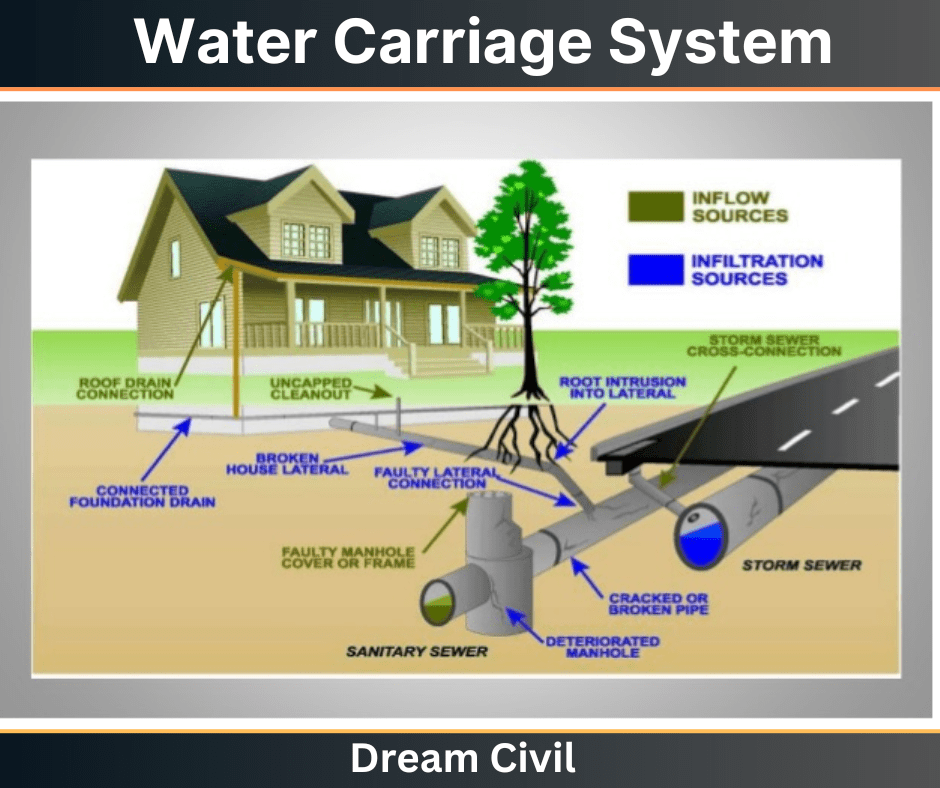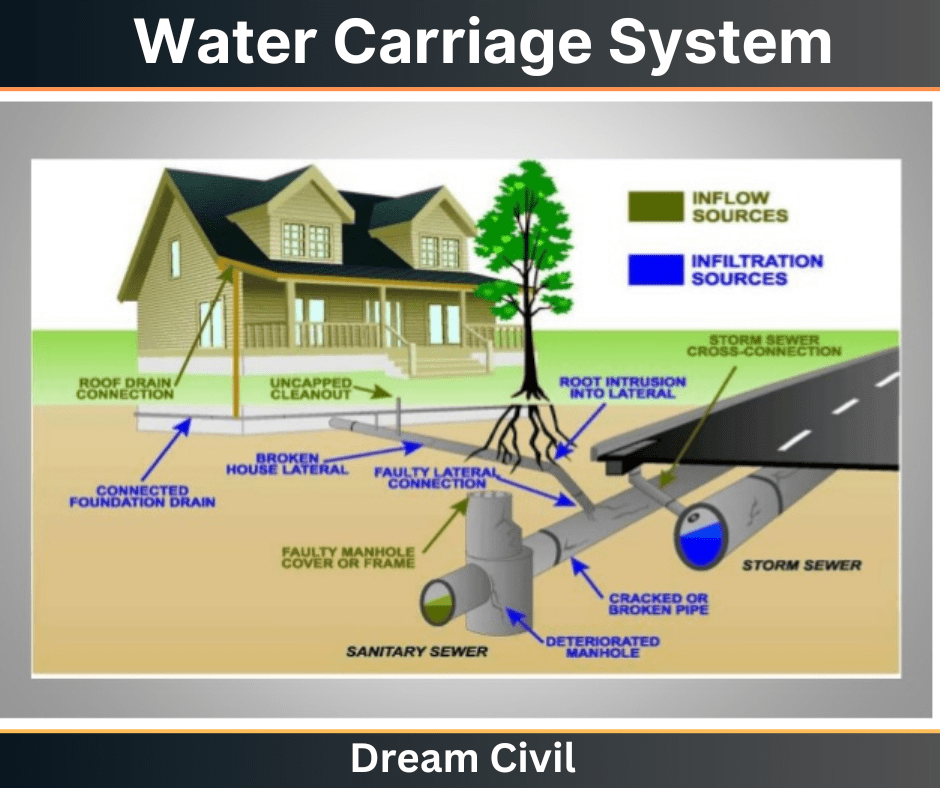Table of Contents
A water Carriage System is a method for the disposal of wastes, where water carries the wastes from its point of production to the point of treatment for final disposal.
The wastes become liquid due to the high quantity of water (99.9%) which is carried by the sewers.
A sewer is a pipe or conduit that carries wastewater.
Solid waste materials like garbage are collected separately from the conservancy system because they may clog the sewers.
Every person uses 5 to 10 liters of water for their hygiene and that wasted water is used for maintaining the flushing system in sewers.
Also, the wastewater from kitchens, baths, washbasins, industries, commercial buildings, etc. is led to the sewers and used for flushing.
Finally, the collected sewerage led by the sewers is then treated suitably and then is disposed of by different methods.

A water carriage system is a sanitation process that is carried out with the help of sewers & water. So, it is also called a water carriage system of sewers.
A. Types of Water Carriage System of Sanitation
There are mainly 3 types of water carriage systems. They are:
1. Separate system
2. Combined system
3. Partially combined system
1. Separate System
In a separate system, there are two separate sewers ( i.e. Foul Sewer & Stormwater Sewer).
Foul sewer is also called sanitary sewer and is used to carry sewage from buildings (but not stormwater) to the point of treatment.
Stormwater sewer is used to carry stormwater from roads, buildings & surfaces. The stormwater is discharged into rivers without treatment.
If a separate outlet for stormwater is available and the topography of the town is such that stormwater can be disposed of in natural drains then, it is suitable to construct a separate system.
i. Advantages of Separate System
a. Load on the treatment unit is low.
b. It is more economical for the long term.
c. It is more uniform.
d. If one sewer gets clogged then it doesn’t affect another sewer system.
e. It is more hygienic and pollution-free as compared to combined & partially combined.
f. It mitigates the problem of flooding.
g. It allows the use of stormwater as a resource.
h. It optimizes the efficiency of the wastewater treatment plant (WWTP).
ii. Disadvantages of Separate System
a. Cleaning of two sewers have to be done.
b. Two sets of sewers are ultimately costly to construct.
c. Confusion about the pipe can be there.
d. Reconstruction process may disrupt the traffic, businesses, etc.
2. Combined System
In Combined System; there is only one set of the sewer.
Sewages from houses and commercial buildings as well as rainwater is carried in the same sewer.
It means that the same sewer act as both sanitary sewer and stormwater sewer.
i. Advantages of Combined System
a. It requires only one sewer. This reduces the cost of construction.
b. Because of the large diameter; cleaning is easy.
c. Self-cleaning velocity can be easily achieved in this method.
ii. Disadvantages of the Combined System
a. Handling and transportation of sewer is difficult.
b. Load on the treatment plant is increased.
c. During heavy rains, it may flow out.
d. They are large which requires more area & get easily silted.
e. Pollution of stormwater unnecessarily.
f. If the pump is required; it becomes uneconomical.
3. Partially Combined System
In this system; only one set of the sewer is there, with one overflow drain connected.
When an overflow drain is added to the combined system; the partially combined system is formed.
i. Advantages of Partially Combined System
a. The cleaning process is easy.
b. It combines the advantages of both.
c. Fewer chances of choking.
ii. Disadvantages of Partially Combined System
a. In dry weather; velocity is low.
b. It increases the treatment load.
B. Advantages of Water Carriage System of Sanitation
Some advantages of the water carriage system are:
1. It improves the aesthetic appearance of the city.
2. As compared to the conservancy system, less area is required.
3. No problem with foul smell or hygienic trouble as it immediately removes excreta with water.
4. Depending on the topography of the town, sewage may or may not require pumping while treating it, before disposing off.
5. Waste materials are treated up to the required degree of sanitation.
6. It makes the environment more hygienic and pollution-free.
C. Disadvantages of Water Carriage System of Sanitation
Some disadvantages of the water carriage system are:
1. The initial cost of construction is high.
2. Operation and maintenance are more costly.
3. It is not suitable for the areas having less water.
Read More: Water treatment processes

